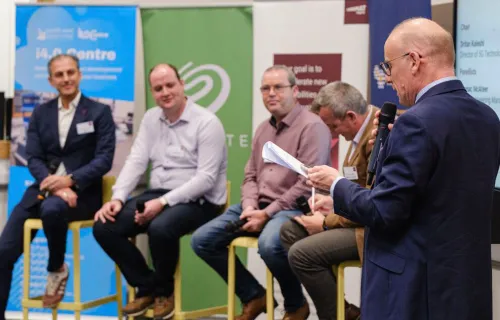5G took a significant step towards becoming a reality with the announcement of the West Midlands as the UK’s first multi-city 5G test bed. The multi million pound trial of new high speed connectivity will test new 5G applications and services at scale, stimulating the development and deployment of 5G networks and creating a template that can be rolled out across the UK.
Scrape the surface of the Department for Digital, Culture, Media and Sport’s (DCMS) vision for the West Midlands Combined Authority’s Urban Connected Community and, to my mind, you find a Smart City.
The UK Smart City vision
The first phase of development will see hospital appointments by video link, ambulances video conferencing with clinical specialists, live streaming of CCTV footage from buses and real-world testing of driverless cars. But beyond these innovative technology use-cases lies a much more wide-ranging vision.
Citizens across different communities will feel engaged and have access to the right information and resources necessary to live a fulfilling life. The business and economic spheres will create and sustain a place to live that’s healthy, innovative and appropriately resourced. Smart, connected, sustainable local economies will be powered by renewable and flexible energy that uses data and technology to drive transformation. And city operations and performance will use data and information from both public and private sources to improve the quality of life for all.
An all-embracing operational model
To make this a reality, the Smart City template will have to find a way to support different organisational models, reflecting how the UK’s Councils and Local Authorities are run. It will need to bring together a myriad number of organisational departments, systems, functions or facilities outsourced, part-outsourced or completely insourced. The template will need to provide as open and effective a way as possible for the public and private sectors to interoperate seamlessly, while also providing the flexibility essential to support the different organisational models.
Establishing the right data handling systems and processes
A fundamental part of driving the digital transformation required to achieve the Smart City vision I outlined earlier will be the identification and capture of the data that will support it, as well as the identification and creation of the systems and processes that will utilise the data. This is where close attention to standards and interoperability is essential, to make sure there are no barriers to this digital transformation. The Smart City’s standards and protocols should be chosen to provide the most holistic data hub and processing platform, and one area to consider from day one will be data security and integrity.
In the UK, the Data Processing Act and GDPR are there to protect our personal data from exposure and abuse, mandating that all systems are designed with security built-in, regardless of what type of network, platform, storage and processing applications are used. This is especially relevant when considering open systems, standards, protocols and open source. The use of open standards and protocols will be crucial when considering how to externally expose data, either raw or processed — especially with GDPR in mind. Therefore, we are probably looking at mainly anonymised data, but anything that is not anonymised must be either encrypted or transmitted securely, preferably both. This would require both parties involved in the data transaction to use the same protocols, interfaces and applications to ensure the data’s integrity. To this, we should also add data classification and tagging, as this will protect the data from misuse by defining how and where it can be used and by whom. Emerging technologies, such as Blockchain, with its distributed ledger and chain of trust, could be embraced further along this path.
The vital role of open standards and APIs
One of the greatest challenges for the West Midlands’ multi-city 5G test bed will be making sure the blueprint developed is replicable and, to achieve that, open standards and APIs will be essential. The use of documented — and widely-supported — standards-based APIs will not just be a boon for external interoperability, it will also help with internal interoperability. It makes no sense to apply standards to the external interfaces and leave the internal ecosystem as a set of unconnected silos, where data transfer is totally proprietary. To prevent vendor lock-in, the interaction between internal systems should be as open and standardised as possible. The use of the same APIs internally as externally will reduce the development and testing efforts, as well as in-life operations and support costs.
Building in true interoperability
Ideally, citizens should be able to move seamlessly between Smart Cities, which is where true interoperability is required. This will require the various standards bodies to collaborate on defining how to support such interoperability. In fact, work is already under way to develop a Smart City standardisation landscape, where the member bodies all have a specific area of focus and are looking to provide a holistic and interoperable standards ecosystem for Smart Cities. It consists of three tiers:
- Strategic — ISO 37120 and BSI 8904 — guidance and leadership
- Process — BSI PAS182/183 — processing and managing
- Technical — ISO/IEC AWI 30145/30146 — building and developing
The result of developing the Smart City template in this way is that new adopters will not have to build everything from scratch. They should be faced with less design and development work, leading to faster and more economical deployment rates, as well as being able to interoperate with existing Smart Cities seamlessly. There will also be the opportunity to refine the template as successive deployments are completed, so that the lessons learned are used to inform those that follow, through evolution of the APIs and not the underlying systems. Existing deployments will be able to stay up-to-date though the adoption of the updated APIs alone.
The future of the Smart City
What else is on the horizon? As part of the template rollout, the creation of a new sector in education and industry, based around the ecosystem deployed in the Smart City, should also follow, as existing deployments will need to be supported and grow as new ones are being deployed. The exchange of information on city performance and advanced analytical research will be able to help to resolve issues or stimulate growth in other cities. The use of the open standards and APIs will also make the information exchange flow as efficiently and securely as possible. Bringing all this to life will result in the development of a city operating system, making the City as a Platform/City as a Service a reality.





